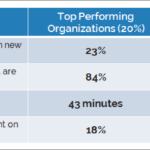DEJ’s new study, “Strategies of Leading Organizations in Adopting Observability” reveals a 3.7 times increase in the number of organizations that are forced to innovate to stay competitive, over the last three years. The study also shows an 8.7 times increase in the number of software releases and updates over the same period of time. However, the research shows that only 39% of these organizations experienced improvements in business performance as a result of innovation. The graphic below analyzes business areas that are impacted by the ineffectiveness of managing innovation.
DEJ’s upcoming study on “Best Practices for Managing Innovation for Achieving Business Outcomes” identifies key strategies and capabilities for managing innovation and modernization and measures their impact on business goals. This DEJ’s Research Note summarizes some of the key findings from this upcoming study.
DEJ’s study identified key challenges for managing innovation to achieve key business goals. Some of these challenges are related to a lack of technology capabilities, but many reasons why innovation initiatives are failing can be connected to business processes and an organizational approach.
The research shows that a missing link in an organizations approach for managing innovation is lack of visibility into both employee and customer experience. Additionally, organizations are struggling to put their innovation initiatives into a business context as they are reporting the inability to measure business impact and a lack of alignment with the key goals as some of the top challenges. As a result, organizations are experiencing a high churn of some of their most valuable employees and are being impacted by issues with customer satisfaction, revenue loss, brand image and deteriorated competitive position. Organizations are also reporting increased cost due to inefficiencies of managing data, computing and people resources. Additionally, 58% of organizations reported that the bandwidth of their developers and engineers is inefficiently used.
The research also shows that finding the right balance between the releases and reliability of digital services remains a magic formula for using technology to achieve key business outcomes. Additionally, one of the key barriers for creating a innovation-driven business value is providing data in actionable context and in a timely manner for building and improving applications, resolving performance issues and continuous innovation. Organizations are also struggling with managing modernization projects and a lack of automation capabilities. Sometimes these two challenges are going hand-in-hand, as many organizations are trying to close a talent gap for modernization by deploying automation and AI capabilities.
Lack of automation capabilities also impacts a number of other areas as DEJ’s research shows a $46 million average annual loss due to a lack of automation capabilities for managing IT performance. Organizations are looking for more automation around testing, resource optimization, addressing performance issues and provisioning and infrastructure provisioning and management.
DEJ’s upcoming study on Managing Kubernetes shows that improving productivity of Developers and engineers and closing a skills gap are two of the key goals for managing Kubernetes. However, the research shows that many organizations are struggling with achieving that goal as 72% of them reported a lack of centralized control as the key challenge. Additionally, 61% of organizations reported a lack of resources as the key challenge as they are spending too much time on troubleshooting performance issues. DEJ’s Observability research found that, as the complexity of modern environments is increasing, the ability to understand the impact of change has become one of the key Observability capabilities and enables leading organizations to reduce their MTTR per incident by 4 times, which allows them to free up more resources for innovation.
As organizations are struggling to use innovation to create a business value, it should be noted that the business impact of ineffectiveness in addressing key challenges is constantly increasing. DEJ’s research shows a 41% increase in revenue loss due to delays in application releases since 2019.
In order to provide a guidance for organizations that are looking to improve business value of their innovation initiatives, DEJ identified a group of top performing organizations (TPOs – top 20%% of research participants based on four KPIs) and analyzed their strategies and capabilities.
The research shows that these organizations are much more likely to effectively address the challenges listed above. More importantly, these organizations are experiencing significant business benefits from deploying the right mix of capabilities. The research shows that TPOs are experiencing 3.6x ROI from modernization projects.
DEJ’s follow up Research Note will analyze competencies that these organizations are deploying and how they impact key business outcomes.






